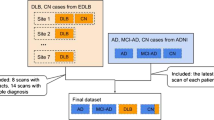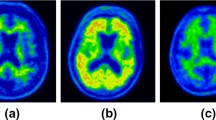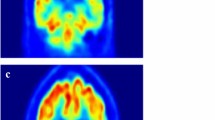Abstract
Alzheimer’s Disease (AD) imposes a heavy burden on health services both due to the large number of people affected as well as the high costs of medical care. Recent research efforts have been dedicated to the development of computational tools to support medical doctors in the early diagnosis of AD. This paper is focused into studying the capacity of Deep Learning (DL) techniques to automatically identify AD based on PET neuroimaging. PET images of the cerebral metabolism of glucose with fluorodeoxyglucose (\(^{18}\)F-FGD) were obtained from the Alzheimer’s Disease Neuroimaging Initiative (ADNI) database. Two DL approaches are compared: a 2D Inception V3 pre-trained model and a custom end-to-end trained 3D CNN to take advantage of the spatial patterns of the full FDG-PET volumes. The results achieved demonstrate that the PET imaging modality is suitable indeed to detect early symptoms of AD. Further to that, the carefully tuned custom 3D CNN model brings computational advantages, while keeping the same discrimination capacity as the exhaustively pre-trained 2D Inception V3 model.
This research work is funded by National Funds through the FCT - Foundation for Science and Technology, in the context of the project UIDB/00127/2020.
Access this chapter
Tax calculation will be finalised at checkout
Purchases are for personal use only
Similar content being viewed by others
References
2020 Alzheimer’s disease facts and figures: Alzheimer’s and Dementia (2020). https://doi.org/10.1002/alz.12068
Aderghal, K., Benois-Pineau, J., Afdel, K., Gwenaëlle, C.: FuseMe: classification of sMRI images by fusion of deep CNNs in 2D+e projections. In: ACM International Conference Proceeding Series (2017). https://doi.org/10.1145/3095713.3095749
Backstrom, K., Nazari, M., Gu, I.Y.H., Jakola, A.S.: An efficient 3D deep convolutional network for Alzheimer’s disease diagnosis using MR images. In: Proceedings of the International Symposium on Biomedical Imaging (2018). https://doi.org/10.1109/ISBI.2018.8363543
Bozhkov, L., Georgieva, P.: Overview of deep learning architectures for EEG-based brain imaging. In: 2018 International Joint Conference on Neural Networks (IJCNN). IEEE (2018)
Bozhkov, L., Georgieva, P.: Deep learning models for brain machine interfaces. Ann. Math. Artif. Intell., 1175–1190 (2019). https://doi.org/10.1007/s10472-019-09668-0
Choi, H., Ha, S., Im, H.J., Paek, S.H., Lee, D.S.: Refining diagnosis of Parkinson’s disease with deep learning-based interpretation of dopamine transporter imaging. NeuroImage Clinical (2017). https://doi.org/10.1016/j.nicl.2017.09.010
Choi, H., Jin, K.H.: Predicting cognitive decline with deep learning of brain metabolism and amyloid imaging. Behav. Brain Res. (2018). https://doi.org/10.1016/j.bbr.2018.02.017
Cole, J.H., et al.: Predicting brain age with deep learning from raw imaging data results in a reliable and heritable biomarker. Neuroimage (2017). https://doi.org/10.1016/j.neuroimage.2017.07.059
Ding, Y., et al.: A deep learning model to predict a diagnosis of Alzheimer disease by using 18 F-FDG PET of the brain. Radiology (2019). https://doi.org/10.1148/radiol.2018180958
Ebrahimighahnavieh, M.A., Luo, S., Chiong, R.: Deep learning to detect Alzheimer’s disease from neuroimaging: a systematic literature review. Comput. Methods Programs Biomed. (2020). https://doi.org/10.1016/j.cmpb.2019.105242
Havaei, M., et al.: Brain tumor segmentation with Deep Neural Networks. Med. Image Anal. (2017). https://doi.org/10.1016/j.media.2016.05.004
Huang, Y., Xu, J., Zhou, Y., Tong, T., Zhuang, X.: Diagnosis of Alzheimer’s disease via multi-modality 3D convolutional neural network. Front. Neurosci. (2019). https://doi.org/10.3389/fnins.2019.00509
Kamnitsas, K., et al.: Efficient multi-scale 3D CNN with fully connected CRF for accurate brain lesion segmentation. Med. Image Anal. (2017). https://doi.org/10.1016/j.media.2016.10.004
Klöppel, S., et al.: Automatic classification of MR scans in Alzheimer’s disease. Brain (2008). https://doi.org/10.1093/brain/awm319
Li, F., Liu, M.: Alzheimer’s disease diagnosis based on multiple cluster dense convolutional networks. Comput. Med. Imaging Graph. (2018). https://doi.org/10.1016/j.compmedimag.2018.09.009
Lian, C., Liu, M., Zhang, J., Shen, D.: Hierarchical fully convolutional network for joint atrophy localization and Alzheimer’s disease diagnosis using structural MRI. IEEE Trans. Pattern Anal. Mach. Intell. (2020). https://doi.org/10.1109/TPAMI.2018.2889096
Lin, W., et al.: Convolutional neural networks-based MRI image analysis for the Alzheimer’s disease prediction from mild cognitive impairment. Front. Neurosci. (2018). https://doi.org/10.3389/fnins.2018.00777
Liu, M., Cheng, D., Wang, K., Wang, Y.: Multi-modality cascaded convolutional neural networks for Alzheimer’s disease diagnosis. Neuroinformatics, 295–308 (2018). https://doi.org/10.1007/s12021-018-9370-4
Liu, M., Zhang, J., Adeli, E., Shen, D.: Landmark-based deep multi-instance learning for brain disease diagnosis. Med. Image Anal. (2018). https://doi.org/10.1016/j.media.2017.10.005
Marcus, C., Mena, E., Subramaniam, R.M.: Brain PET in the diagnosis of Alzheimer’s disease (2014). https://doi.org/10.1097/RLU.0000000000000547
Punjabi, A., Martersteck, A., Wang, Y., Parrish, T.B., Katsaggelos, A.K.: Neuroimaging modality fusion in Alzheimer’s classification using convolutional neural networks. PLoS ONE (2019). https://doi.org/10.1371/journal.pone.0225759
Qiu, S., Chang, G.H., Panagia, M., Gopal, D.M., Au, R., Kolachalama, V.B.: Fusion of deep learning models of MRI scans, Mini-Mental State Examination, and logical memory test enhances diagnosis of mild cognitive impairment. Alzheimer’s Dement. Diagn. Assess. Dis. Monit. (2018). https://doi.org/10.1016/j.dadm.2018.08.013
Senanayake, U., Sowmya, A., Dawes, L.: Deep fusion pipeline for mild cognitive impairment diagnosis. In: Proceedings of the International Symposium on Biomedical Imaging (2018). https://doi.org/10.1109/ISBI.2018.8363832
Shmulev, Y., Belyaev, M.: Predicting conversion of mild cognitive impairments to Alzheimer’s disease and exploring impact of neuroimaging. In: Stoyanov, D., et al. (eds.) GRAIL/Beyond MIC 2018. LNCS, vol. 11044, pp. 83–91. Springer, Cham (2018). https://doi.org/10.1007/978-3-030-00689-1_9
Singh, S.P., Wang, L., Gupta, S., Goli, H., Padmanabhan, P., Gulyás, B.: 3d deep learning on medical images: a review (2020). https://doi.org/10.3390/s20185097
Stier, N., Vincent, N., Liebeskind, D., Scalzo, F.: Deep learning of tissue fate features in acute ischemic stroke. In: Proceedings - 2015 IEEE International Conference on Bioinformatics and Biomedicine, BIBM 2015 (2015). https://doi.org/10.1109/BIBM.2015.7359869
Valliani, A., Soni, A.: Deep residual nets for improved Alzheimer’s diagnosis. In: ACM-BCB 2017 - Proceedings of the 8th ACM International Conference on Bioinformatics, Computational Biology, and Health Informatics (2017). https://doi.org/10.1145/3107411.3108224
Author information
Authors and Affiliations
Corresponding author
Editor information
Editors and Affiliations
Rights and permissions
Copyright information
© 2022 Springer Nature Switzerland AG
About this paper
Cite this paper
Bastos, J., Silva, F., Georgieva, P. (2022). Deep Learning for Diagnosis of Alzheimer’s Disease with FDG-PET Neuroimaging. In: Pinho, A.J., Georgieva, P., Teixeira, L.F., Sánchez, J.A. (eds) Pattern Recognition and Image Analysis. IbPRIA 2022. Lecture Notes in Computer Science, vol 13256. Springer, Cham. https://doi.org/10.1007/978-3-031-04881-4_8
Download citation
DOI: https://doi.org/10.1007/978-3-031-04881-4_8
Published:
Publisher Name: Springer, Cham
Print ISBN: 978-3-031-04880-7
Online ISBN: 978-3-031-04881-4
eBook Packages: Computer ScienceComputer Science (R0)





